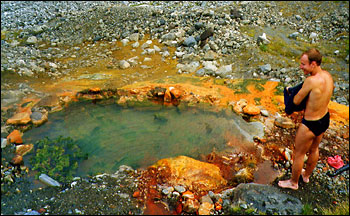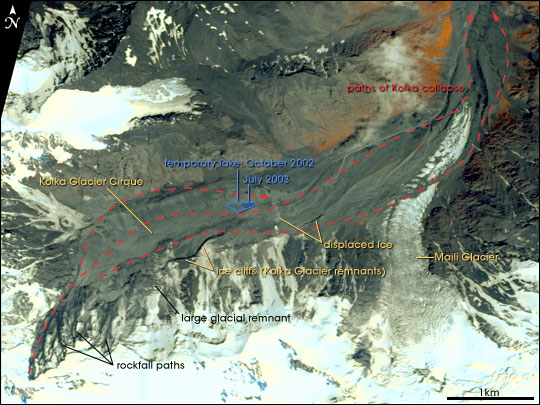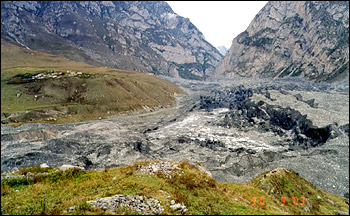

Dormant but Dangerous |
|||
There are more than a dozen other scientists studying the event, and, so far, no one—including Petrakov, Chernomorets, and Tutubalina—is sure what the root cause of the catastrophe was. “To the east and a little south of Kolka is the Kazbek volcano,” says Chernomorets. Volcanism of the dormant Kazbek is responsible for the area’s popular hot springs. “There was a lot of water associated with this event, and we don’t think all of it could have come from the heating caused by friction as the ice mass moved. So one of the questions about this collapse is where did all the water come from?” |
|||

There is uncertainty also about what triggered the collapse of rocks and hanging glaciers on Mount Dzhimarai-Khokh. Two small earthquakes jarred the region in the months before the collapse, and probably destabilized the hanging glaciers. There is another interesting factor to consider: in the first days after the collapse, an Emercom crew flew to the site via helicopter, but was forced to evacuate immediately when the crew detected an overpowering smell of sulfur-containing gas. It seems there may be some fumaroles—volcanic vents—on the face of Mount Dzhimarai-Khokh in the area where the hanging glacier collapsed. As for excessive snowfall, says the team, “It was insignificant compared to the total amount of material moved in the event. If the snowfall played any role, we believe it was secondary to volcanic and tectonic influences.” The future of Kolka and the Karmadon Ice MassIn a paper that has been recently published in the Russian Journal Kriosfera Zemli, Petrakov, Tutubalina, and Chernomorets present their findings from the previous year in the form of maps and annotated satellite images of the catastrophe area. The maps include the extent of the ice mass and debris fields, the location of temporary lakes and flooded and buried settlements, and the former and current extent of the glaciers in the Kolka cirque. |
Mount Kazbek is a dormant volcano, and hot springs (such as this pool that Russian scientist Dmitry Petrokov prepares to soak in) and other geothermal features are common in the area. Increased volcanic activity may have warmed the ground beneath the Kolka Glacier, softening the bottom layer of ice and priming the glacier for disintegration. (Photograph courtesy Sergey Chernomorets) | ||
 | |||
Based on the available data and observations, the scientists say they don’t expect any additional catastrophic processes within the next 10 to 20 years. The remaining lakes will likely continue to drain through crevasses and channels being cut through the ice mass, and as they drain, the risk of flooding decreases. “The rivers are eroding the ice mass faster than we previously anticipated,” says Tutubalina. “The ice mass will have largely melted in 2-3 years, we think, but may take up to 10 years to completely disappear.” Some of the slope glaciers that are being bombarded with rock falls from Mt. Dzhimarai-Khokh may eventually collapse into the basin of the Kolka cirque, but there is so little of the Kolka Glacier remaining below, that such a collapse isn’t likely to trigger any catastrophic avalanches. |
Russian scientists combined satellite data with ground observations to create maps of the Kolka Glacier Cirque. This Indian Remote Sensing Satellite image (acquired July 11, 2003) shows details of the cirque, including scars caused by post-collapse rockfall, a large remnant of the Kolka Glacier, ice cliffs high above the floor of the cirque, displaced porous ice, the Maili Glacier, a temporary lake, and deposits of rubble left along the path of the collapsing glacier. (Image copyright ANTRIX, Space Imaging Inc., R&D Center ScanEx) | ||

Meanwhile, grass has started colonizing the super elevations and softening the raw, scoured look of the slopes. “The whole area is changing so fast that we are rapidly losing evidence that would increase our understanding of the processes involved in the collapse. We must speed up our observations of the area before too much valuable information is lost,” says Chernomorets. For example, on the August 2003 expedition, the scientists were guided by a recent high-resolution image from the IRS sensor. “On the image, we could see some unusual textures that were not typical for glaciers in the area,” noted Tutubalina. Some of these textures turned out to be piles of porous, granulated ice lining the sides and bottom of the remains of the Kolka Glacier. This material is not typical glacier ice, which shows distinct, compressed layers that reflect centuries of yearly snowfall. Chernomorets thinks an expert on ice and snow crystals should examine the material to see if they contain clues about the forces involved in the collapse. There is no shortage of ideas for further studies. They want a vertical sounding survey of the new thickness of the Kolka Glacier. They also want to work with geologists to map tectonic fault lines in the Kolka Cirque; the ongoing rock falls and debris flows make them wonder about tectonic instability. And of course, they want to have someone collect air samples at the suspected fumaroles. “We have to remember that in addition to the 1902 event at Kolka, there are historical accounts of glacier collapses on the southern and eastern slopes of Kazbek in the past few centuries,” says Chernomorets. Dormant, but still dangerous, the volcano could be the key to them all. |
The ice in the Karmadon Depression is steadily melting and being washed away by streams and rivers. Most of it will be gone in 2 or 3 years, but other scars will last far longer. (Photograph courtesy Dmitry Petrakov) | ||